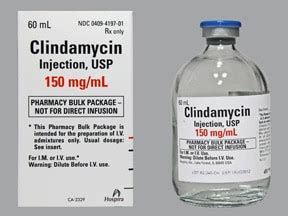Intro
Discover the uses, side effects, and dosage of Clindamycin 300 Mg, a powerful antibiotic for bacterial infections. Learn how it treats acne, skin infections, and respiratory issues, while understanding potential side effects and interactions. Get expert advice on proper dosage and usage to ensure safe and effective treatment.
Clindamycin is a popular antibiotic medication used to treat various bacterial infections. It belongs to the lincosamide class of antibiotics and works by inhibiting the growth of bacteria, thereby preventing the spread of infection. In this article, we will discuss the uses, side effects, and dosage of Clindamycin 300 mg, as well as its mechanism of action, benefits, and potential interactions.
What is Clindamycin 300 mg used for?
Clindamycin 300 mg is used to treat a range of bacterial infections, including:
- Skin infections, such as acne, cellulitis, and abscesses
- Respiratory infections, such as pneumonia and bronchitis
- Bone and joint infections, such as osteomyelitis and septic arthritis
- Gastrointestinal infections, such as diverticulitis and peritonitis
- Gynecological infections, such as pelvic inflammatory disease and endometritis

How does Clindamycin 300 mg work?
Clindamycin 300 mg works by binding to the bacterial ribosome, which is responsible for protein synthesis. This binding inhibits the growth of bacteria, ultimately leading to their death. Clindamycin is effective against a range of bacteria, including Staphylococcus aureus, Streptococcus pneumoniae, and Bacteroides fragilis.
Benefits of Clindamycin 300 mg
Clindamycin 300 mg has several benefits, including:
- Broad-spectrum activity: Clindamycin is effective against a range of bacteria, making it a versatile treatment option.
- Oral bioavailability: Clindamycin is well-absorbed when taken orally, making it a convenient treatment option.
- Penetration into tissues: Clindamycin penetrates well into tissues, making it effective against infections in various parts of the body.
Side effects of Clindamycin 300 mg
Like all medications, Clindamycin 300 mg can cause side effects, including:
- Gastrointestinal side effects: nausea, vomiting, diarrhea, and abdominal pain
- Skin reactions: rash, itching, and urticaria
- Allergic reactions: anaphylaxis and angioedema
- Hematological side effects: thrombocytopenia, neutropenia, and agranulocytosis

Dosage of Clindamycin 300 mg
The dosage of Clindamycin 300 mg varies depending on the type and severity of the infection, as well as the patient's age and weight. The typical dosage is:
- Adults: 300-450 mg every 6-8 hours
- Children: 8-16 mg/kg/day divided into 3-4 doses
Interactions with Clindamycin 300 mg
Clindamycin 300 mg can interact with other medications, including:
- Erythromycin: increased risk of cardiac arrhythmias
- Warfarin: increased risk of bleeding
- Theophylline: increased risk of seizures

Precautions and contraindications
Clindamycin 300 mg is contraindicated in patients with:
- Hypersensitivity to clindamycin or lincomycin
- Severe gastrointestinal disease
- History of Clostridioides difficile-associated diarrhea
Pregnancy and breastfeeding
Clindamycin 300 mg is classified as a category B medication, meaning it is generally safe to use during pregnancy. However, it is essential to consult a healthcare provider before taking Clindamycin 300 mg during pregnancy or breastfeeding.
Frequently Asked Questions
What is Clindamycin 300 mg used for?
+Clindamycin 300 mg is used to treat various bacterial infections, including skin, respiratory, bone and joint, gastrointestinal, and gynecological infections.
How does Clindamycin 300 mg work?
+Clindamycin 300 mg works by binding to the bacterial ribosome, inhibiting protein synthesis and ultimately leading to the death of the bacteria.
What are the common side effects of Clindamycin 300 mg?
+The common side effects of Clindamycin 300 mg include gastrointestinal side effects, skin reactions, allergic reactions, and hematological side effects.
Conclusion
Clindamycin 300 mg is a versatile antibiotic medication used to treat various bacterial infections. While it is generally safe and effective, it is essential to be aware of its potential side effects, interactions, and contraindications. If you have any questions or concerns about Clindamycin 300 mg, consult a healthcare provider to determine the best course of treatment for your specific needs.
We hope this article has provided you with valuable information about Clindamycin 300 mg. If you have any further questions or comments, please don't hesitate to share them with us.
